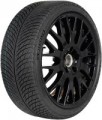Speed rating
The speed rating that the tyre corresponds to.
This indicator determines the maximum speed that tyre is allowed to operate. It is designated by the letters of the Latin alphabet, each of which corresponds to a certain speed limit:
F — 80 km/h; G — 90 km/h; J — 100 km/h; K — 110 km/h; L — 120 km/h; M — 130 km/h; N — 140 km/h; P —
150 km/h ; Q —
160 km/h ; R —
170 km/h ; S —
180 km/h ; T —
190 km/h ; U —
200 km/h ; H —
210 km/h ; V —
240 km/h ; W —
270 km/h ; Y —
300 km/h ;
The maximum permitted speed must not be exceeded — this creates the risk of an accident. However, there are other rules associated with choosing a tyre by this factor. So, ideally, the actual driving speed should be at least 10 – 15% lower than the speed rating of the installed tyres — this will give an additional guarantee in case of emergency situations. In addition, in some tyre models, as the speed approaches the maximum, the upper limit of allowable load is reduced; see “Load Index” for details.
Wet Grip
An index that determines the overall performance of a tyre on wet pavement. Lettered from
A(highest) to
G(lowest); intermediate options, respectively —
B,
C,
D,
E and
F.
The higher this indicator, the stronger the tyre grips to the wet road, the more efficient and safer it will be in difficult weather conditions. At the same time, it is worth noting that a low grip index does not mean unsuitability for driving in rain or snow — you just need to be more careful using such tyres. Conversely, a high index does not relieve the driver of the need to be careful in difficult weather conditions.
Noise Level
The average noise level created by a tyre while driving. The lower this indicator, the more comfortable this model will be, the less additional noise it will create.
Note that EU rules provide 3 categories of tyres in terms of noise.
“Quiet” are considered models with an index of up to 68 dB,
“medium” — 68 – 71 dB,
“loud” — 72 dB and above.
Homologation for
Vehicle manufacturer's recommendations for ideal tyres for a specific vehicle model. Homologated tyres take into account the technical and design features of machine, up to factory suspension settings, thanks to which it is possible to unleash the full potential of the “iron horse”. It is recommended that tyres approved by the manufacturer be installed only on the wheels of suitable vehicles, and in some cases, without the use of homologated tyres, machine risks losing the warranty. Tyre sharpening for a specific brand and model of car is indicated by specialized homologation markings.
On the shelves of tyre stores, homologated tyres are most often presented for the following car brands:
Audi(including
Audi RS,
Alfa Romeo,
BMW / Mini,
Ferrari,
Mercedes-Benz(including
Mercedes AMG),
Maserati,
Porsche,
Tesla,
Volvo,
Volkswagen.

